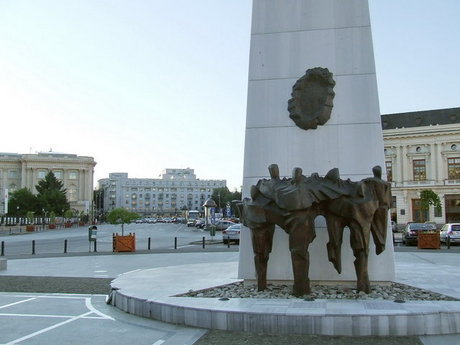Revolution Square
Revolution Square (Romanian: Piaţa Revoluţiei) is a square in central Bucharest, on Calea Victoriei. Known as Piaţa Palatului (Palace Square) until 1989, it was later renamed after the 1989 Romanian Revolution.
The former Royal Palace (now the National Museum of Art of Romania), the Athenaeum, the Athénée Palace Hotel, the University of Bucharest Library and the Memorial of Rebirth are located here. The square also houses the building of the former Central Committee of the Romanian Communist Party (from where Nicolae Ceauşescu and his wife fled by helicopter on December 22, 1989). In 1990, the building became the seat of the Senate and since 2006 it houses the Ministry of Interior and Administrative Reform.
Prior to 1948, an equestrian statue of Carol I of Romania stood there. Created in 1930 by the Croatian and American sculptor Ivan Meštrović, the statue was destroyed in 1948 by the Communists, who never paid damages to the sculptor. In 2005, the Romanian Minister of Culture decided to recreate the destroyed statue from a model that was kept by Meštrović's family. In 2007, the Bucharest City Hall assigned the project to the sculptor Florin Codre, who is going to design an original statue of Carol inspired by Meštrović's model (most consider it a plagiarism).
In August 1968 and December 1989, the square was the site of a two mass meetings which represented the apogee and the nadir of Ceauşescu's regime. The 1968 moment marked the highest point in Ceauşescu's popularity, when he openly condemned the invasion of Czechoslovakia and started pursuing a policy of independence from Kremlin. The 1989 meeting was meant to emulate the 1968 assembly and presented by the official media as a "spontaneous movement of support for Ceauşescu", erupting in the popular revolt which led to the end of the regime.
The square gained worldwide notoriety when TV stations around the globe broadcasted Nicolae Ceausescu's final moments in power on December 21, 1989. It was here, at the balcony of the former Communist Party Headquarters, that Ceausescu stared in disbelief as the people gathered in the square below turned on him. He fled the angry crowd in his white helicopter, only to be captured outside of the city a few hours later.
The square's importance stretches back long before the dramatic events of the 1989 Revolution. On the far side of the square stands the former Royal Palace, now home to the National Art Museum, the stunning Romanian Athenaeum and the historic Athenee Palace Hotel. At the south end of the square, you can visit the small, but beautiful, Kretzulescu Church.
The Memorial of Rebirth (Memorialul Renaşterii in Romanian) is a memorial in Bucharest, Romania that commemorates the struggles and victims of the Romanian Revolution of 1989, which overthrew Communism. The memorial complex was inaugurated in August 2005 in Revolution Square, where Romania's Communist-era dictator, Nicolae Ceauşescu, was publicly overthrown in December 1989.
The memorial, designed by Alexandru Ghilduş, features as its centrepiece a 25-metre-high marble pillar reaching up to the sky, upon which a metal "crown" is placed. The pillar is surrounded by a 600 m² plaza covered by marble and granite.
The memorial cost 5.6 million lei (RON 5.6 million, ROL 56 billion, approximately €1.5 million). Its initial name was "Eternal Glory to the Heroes and the Romanian Revolution of December 1989" (Glorie Eternă Eroilor şi Revoluţiei Române din Decembrie 1989). The memorial's name alludes to Romania's rebirth as a nation after the collapse of Communism. Despite a commonly-acknowledged need for a memorial commemorating Romania's 1989 revolution, the monument sparked a significant amount of controversy when it was inaugurated in 2005, mainly to do with its design. Many artists stated that the memorial, especially its central pillar, was devoid of any symbolism, being too abstract, and thus didn't adequately represent the suffering and magnitude of the 1989 revolution, which claimed around 1,500 lives.
The square is accessible from the both international airports via bus or taxi.




